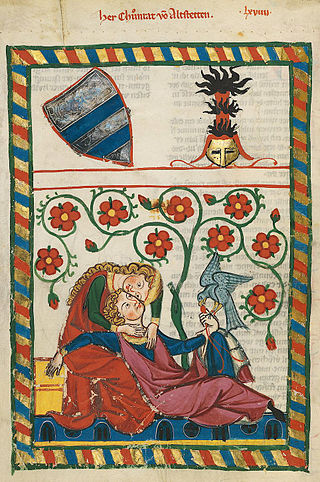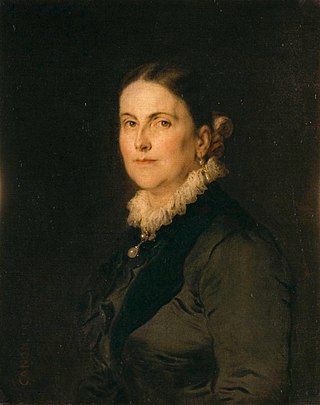Related Research Articles

Harburg is a town in the Donau-Ries district, in Swabia, Bavaria, Germany. It is situated on the river Wörnitz and on the southeastern edge of the Ries meteorite crater in the UNESCO Global Geopark Ries.

The so-called Codex Wallerstein or Vonn Baumanns Fechtbuch is a 16th-century convolution of three 15th-century fechtbuch manuscripts, with a total of 221 pages.

Heldenbücher is the conventional title under which a group of German manuscripts and prints of the 15th and 16th centuries has come down to us. Each Heldenbuch contains a collection of primarily epic poetry, typically including material from the Theodoric cycle, and the cycle of Hugdietrich, Wolfdietrich and Ortnit. The Heldenbuch texts are thus based on medieval German literature, but adapted to the tastes of the Renaissance.

The Bavarian State Library in Munich is the central "Landesbibliothek", i. e. the state library of the Free State of Bavaria, the biggest universal and research library in Germany and one of Europe's most important universal libraries. With its collections currently comprising around 10.89 million books, it ranks among the leading research libraries worldwide. The Bayerische Staatsbibliothek furthermore is Europe's second-largest journals library. Furthermore, its historical holdings encompass one of the most important manuscript collections of the world, the largest collection of incunabula worldwide, as well as numerous further important special collections. Its collection of historical prints before 1850 totals almost one million units.

Josef Fiala, was a Czech composer, oboist, viola da gamba virtuoso, cellist, and pedagogue of the Classical period.

The Répertoire International des Sources Musicales is an international non-profit organization, founded in Paris in 1952, with the aim of comprehensively documenting extant historical sources of music all over the world. It is the largest organization of its kind and the only entity operating globally to document written musical sources. RISM is one of the four bibliographic projects sponsored by the International Musicological Society and the International Association of Music Libraries, Archives and Documentation Centres, the others being Répertoire International de Littérature Musicale, Répertoire international d'iconographie musicale, and Répertoire international de la presse musicale.

The State Library of Württemberg is a large library in Stuttgart, Germany, which traces its history back to the ducal public library of Württemberg founded in 1765. It holds c. 4 million volumes and is thus the fourth-largest library in the state of Baden-Württemberg. The WLB owns an important collection of medieval manuscripts as well as one of the largest Bible collections in the world.

G. Henle Verlag is a German music publishing house specialising in Urtext editions of classical music. The catalogue includes works by composers from different epochs periods, in particular composers from the Baroque to the early twentieth century whose works are no longer subject to copyright. In addition to sheet music, G. Henle Publishers also produces scholarly complete editions, books, reference works, and journals. Since 1995, Henle the range also includes pocket scores. In 2016 Henle began offering the Urtext editions in digital format in an app for iOS and Android tablets.

St. Mang's Abbey, Füssen or Füssen Abbey was a Benedictine monastery in Füssen in Bavaria, Germany. It was founded in the 9th century, and dissolved during the post-Napoleonic secularisation of Bavaria.

The Bibliotheca Palatina of Heidelberg was the most important library of the German Renaissance, numbering approximately 5,000 printed books and 3,524 manuscripts. The Bibliotheca was a prominent prize captured during the Thirty Years' War, taken as booty by Maximilian of Bavaria, and given to the Pope in a symbolic and political gesture. While some of the books and manuscripts are now held by the University of Heidelberg, the bulk of the original collection is now an integral part of the Bibliotheca Apostolica Vaticana at the Vatican.

Minuscule 2814, Aν20, formerly labelled as 1rK in all catalogues, but subsequently renumbered as a 2814 by Aland, is a Greek minuscule manuscript of the New Testament, dated palaeographically to the 12th century.

The House of Oettingen was a high-ranking noble Franconian and Swabian family. It ruled various estates that composed the County of Oettingen between the 12th century and the beginning of the 19th century. In 1674 the house was raised to the rank of prince for the first time. Despite the annexation of their lands following the German mediatisation of 1806, the family retained their titles and still have representatives today.

Louis Kraft Ernest, Prince of Oettingen-Wallerstein was a Bavarian statesman and German prince of the House of Oettingen-Wallerstein. He succeeded his father as ruling Prince of Wallerstein in 1802 but lost his sovereignty in 1806 due to Mediatisation.

The Baden State Library is a large universal library in Karlsruhe. Together with the Württembergische Landesbibliothek, the BLB is the legal deposit and regional library for Baden-Württemberg.

Princess Henriette of Liechtenstein was a Princess of Liechtenstein and member of the Princely House of Liechtenstein.

Harburg Castle in Harburg, Bavaria, in the Donau-Ries district, is an extensive mediaeval complex from the 11th / 12th century. Originally it was a Staufer castle and was owned by the princely House of Oettingen-Wallerstein. Since 2000 the castle belongs to the Prince of Oettingen-Wallerstein Cultural Foundation, which has the mission to preserve this unique castle for the present and future.
Günther Grünsteudel is a German librarian who has become known through his publications on musicology and regional topics concerning Augsburg.

The Universitätsbibliothek Würzburg is the central library of the Julius-Maximilians-Universität Würzburg. As a regional library of Lower Franconia, it collects Lower Franconian literature. The Universitätsbibliothek Würzburg is maintained by the Free State of Bavaria. With 3.6 million media, it is one of the largest libraries in Bavaria.